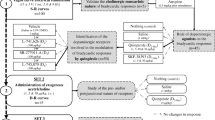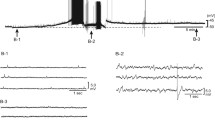Summary
Rabbit atria were isolated with the extrinsic right vagus and sympathetic nerves intact and perfused with Tyrode solution. Noradrenaline overflow evoked by sympathetic nerve stimulation (SNS) at 3 Hz for 3 min was determined before, during, and after vagus nerve stimulation (VNS), also at 3 Hz and for 3 min. The VNS pulses preceded the SNS pulses by 3, 100 and 233 ms. Acetylcholine overflow was determined after labelling of the transmitter stores with [14C]choline.
Pirenzepine 80 nmol/l failed to alter the muscarinic inhibition of noradrenaline overflow when the vago-sympathetic impulse intervals were 3 and 233 ms. At an interval of 100 ms VNS did not significantly inhibit noradrenaline overflow in the absence of pirenzepine but produced an inhibition in the presence of the drug. When the pirenzepine concentration was varied (0.4–300 nmol/l) the largest inhibition of noradrenaline overflow was observed at 5.7 nmol/l whereas 300 nmol/l fully antagonized the inhibition. Acetylcholine overflow evoked by VNS was not altered by pirenzepine 0.4–300 nmol/l.
AF-DX 116 (11-[{2[oi(diethylamino)methyl]-1-piperidinyl}-acetyl]-5,11-dihydro-6H-pyrido-[2,3-b]-[1,4]benzodiazepine-6-one), an M2 receptor selective antagonist, concentration-dependently (100–800 nmol/l) inhibited the decrease of tension development elicited by VNS. At the 100 ms vago-sympathetic impulse interval noradrenaline overflow was enhanced in the presence of AF-DX 116 400 and 800 nmol/l. However, already 100 nmol/l of the drug caused a maximum (fourfold) increase of acetylcholine overflow.
It is concluded that acetylcholine released onto noradrenergic nerve fibres causes a small facilitation of noradrenaline overflow at a vago-sympathetic impulse interval of 100 ms. This response is mediated by an M1 receptor and is superimposed on the well-known M2 receptor mediated inhibition of noradrenaline release which is obtained at vago-sympathetic impulse intervals ranging between 3 and 233 ms. The M2 autoreceptor regulating acetylcholine release is activated by lower synaptic concentrations of the transmitter than the M2 heteroreceptor regulating noradrenaline release.
Similar content being viewed by others
Abbreviations
- SNS:
-
sympathetic nerve stimulation
- VNS:
-
vagus nerve stimulation
References
Altes U, Habermeier-Muth A, Muscholl E (1990) Further evidence for a presynaptic excitatory M1 muscarine receptor at post-ganglionic cardiac adrenergic nerves. Naunyn-Schmiedeberg's Arch Pharmacol 341 Suppl:R 86
Ashe JH, Yarosh CA (1984) Differential and selective antagonism of the slow-inhibitory postsynaptic potential and slow-excitatory postsynaptic potential by gallamine and pirenzepine in the superior cervical ganglion of the rabbit. Neuropharmacology 23:1321–1339
Bognar IT, Baumann B, Dammann F, Knöll B, Meincke M, Pallas S, Fuder H (1989) M2 muscarinic receptors on the iris sphincter muscle differ from those on iris noradrenergic nerves. Eur J Pharmacol 163:263–274
Brown DA, Forward A, Marsh S (1980) Antagonist discrimination between ganglionic and ileal muscarinic receptors. Br J Pharmacol 71:362–364
Fuder H, Rink D, Muscholl E (1982) Sympathetic nerve stimulation on the perfused rat heart. Affinities of N-methylatropine and pirenzepine at pre- and postsynaptic muscarine receptors. Naunyn-Schmiedeberg's Arch Pharmacol 318:210–219
Habermeier-Muth A, Muscholl E (1988) Short- and long-latency muscarinic inhibition of noradrenaline release from rabbit atria induced by vagal stimulation. J Physiol (Lond) 401:277–293
Hammer R, Giachetti A (1982) Muscarinic receptor subtypes: M1 and M2biochemical and functional characterization. Life Sci 31:2991 -2998
Holm S (1979) A simple sequentially rejective multiple test procedure. Scand J Statist 6:65–70
Lindmar R, Loffelholz K, Weide W, Witzke J (1980) Neuronal uptake of choline following release of acetylcholine in the perfused heart. J Pharmacol Exp Ther 215:710–715
Löffelholz K, Muscholl E (1970) Inhibition by parasympathetic nerve stimulation of the release of the adrenergic transmitter. Naunyn-Schmiedeberg's Arch Pharmacol 267:181–184
Micheletti R, Montagna E, Giachetti A (1987) AF-DX 116, a cardioselective muscarinic antagonist. J Pharmacol Exp Ther 241:628–634
Micheletti R, Schiavone A, Giachetti A (1988) Muscarinic M1 receptors stimulate a nonadrenergic noncholinergic inhibitory pathway in the isolated rat duodenum. J Pharmacol Exp Ther 244:680–684
Muscholl E (1990) The role of vagus activity in the presynaptic control of noradrenaline release from rabbit atria. Neurochem Int (in press)
Muscholl E, Muth A (1982) The effect of physostigmine on the vagally induced muscarinic inhibition of noradrenaline release from the isolated perfused rabbit atria. Naunyn-Schmiedeberg's Arch Pharmacol 320:160–169
Muscholl E, Habermeier-Muth A, Jung B (1988) Cholinergic-adrenergic presynaptic interactions on the heart in the millisecond range as studied with the pulse-to-pulse method. In: Hertting G, Spatz HC (eds) Modulation of synaptic transmission and plasticity in nervous systems. NATO ASI Series, vol H19. Springer, Berlin Heidelberg New York Tokyo, pp 111–125
Muscholl E, Forsyth KM, Habermeier-Muth A (1989) A presynaptic excitatory M1 muscarine receptor at postganglionic cardiac adrenergic fibres that is activated by endogenous acetylcholine. Naunyn-Schmiedeberg's Arch Pharmacol 339 Suppl:R 88
Newberry NR, Priestley T, Woodruff GN (1985) Pharmacological distinction between two muscarinic responses on the isolated superior cervical ganglion of the rat. Fur J Pharmacol 116: 191–192
Racké K, Muscholl E (1986) Release of endogenous 3,4-dihydroxyphenylethylamine and its metabolites from the isolated neurointermediate lobe of the rat pituitary gland. Effects of electrical stimulation and of inhibition of monoamine oxidase and reuptake. J Neurochem 46:745–752
Sachs L (1984). Angewandte Statistik, 6th ed. Springer, Berlin Heidelberg New York Tokyo
Yarosh CA, Olito AC, Ashe JH (1988) AF-DX 116: A selective antagonist of the slow inhibitory postsynaptic potential and methacholine-induced hyperpolarization in superior cervical ganglion of the rabbit. J Pharmacol Exp Ther 245:419–425
Author information
Authors and Affiliations
Additional information
Send offprint requests to: E. Muscholl at the above address
Rights and permissions
About this article
Cite this article
Habermeier-Muth, A., Altes, U., Forsyth, K.M. et al. A presynaptic excitatory M1 muscarine receptor at postganglionic cardiac noradrenergic nerve fibres that is activated by endogenous acetylcholine. Naunyn-Schmiedeberg's Arch Pharmacol 342, 483–489 (1990). https://doi.org/10.1007/BF00169033
Received:
Accepted:
Issue Date:
DOI: https://doi.org/10.1007/BF00169033




